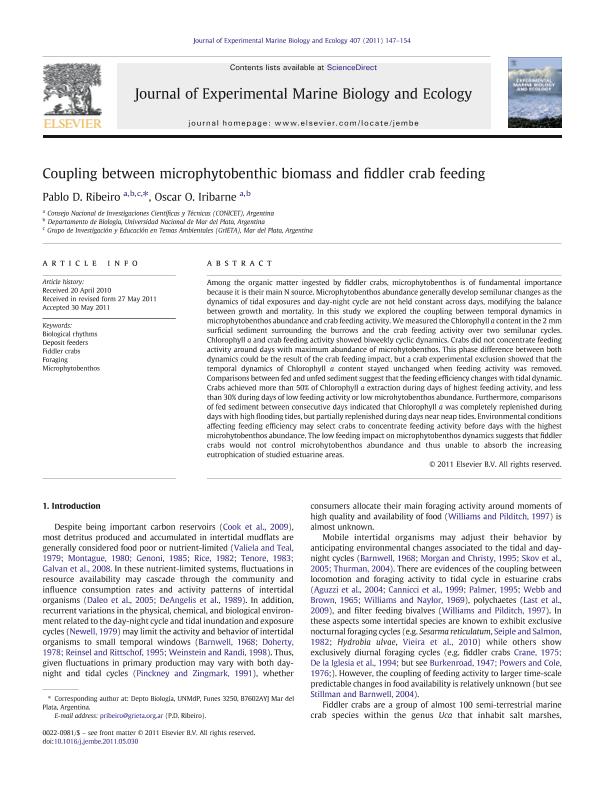Artículo
Coupling between microphytobenthic biomass and fiddler crab feeding
Fecha de publicación:
10/2011
Editorial:
Elsevier Science
Revista:
Journal of Experimental Marine Biology and Ecology
ISSN:
0022-0981
Idioma:
Inglés
Tipo de recurso:
Artículo publicado
Clasificación temática:
Resumen
Among the organic matter ingested by fiddler crabs, microphytobenthos is of fundamental importance because it is their main N source. Microphytobenthos abundance generally develop semilunar changes as the dynamics of tidal exposures and day-night cycle are not held constant across days, modifying the balance between growth and mortality. In this study we explored the coupling between temporal dynamics in microphytobenthos abundance and crab feeding activity. We measured the Chlorophyll a content in the 2. mm surficial sediment surrounding the burrows and the crab feeding activity over two semilunar cycles. Chlorophyll a and crab feeding activity showed biweekly cyclic dynamics. Crabs did not concentrate feeding activity around days with maximum abundance of microhytobenthos. This phase difference between both dynamics could be the result of the crab feeding impact, but a crab experimental exclusion showed that the temporal dynamics of Chlorophyll a content stayed unchanged when feeding activity was removed. Comparisons between fed and unfed sediment suggest that the feeding efficiency changes with tidal dynamic. Crabs achieved more than 50% of Chlorophyll a extraction during days of highest feeding activity, and less than 30% during days of low feeding activity or low microhytobenthos abundance. Furthermore, comparisons of fed sediment between consecutive days indicated that Chlorophyll a was completely replenished during days with high flooding tides, but partially replenished during days near neap tides. Environmental conditions affecting feeding efficiency may select crabs to concentrate feeding activity before days with the highest microhytobenthos abundance. The low feeding impact on microphytobenthos dynamics suggests that fiddler crabs would not control microhytobenthos abundance and thus unable to absorb the increasing eutrophication of studied estuarine areas.
Palabras clave:
BIOLOGICAL RHYTHMS
,
DEPOSIT FEEDERS
,
FIDDLER CRABS
,
FORAGING
,
MICROPHYTOBENTHOS
Archivos asociados
Licencia
Identificadores
Colecciones
Articulos(IIMYC)
Articulos de INSTITUTO DE INVESTIGACIONES MARINAS Y COSTERAS
Articulos de INSTITUTO DE INVESTIGACIONES MARINAS Y COSTERAS
Citación
Ribeiro, Pablo Damián; Iribarne, Oscar Osvaldo; Coupling between microphytobenthic biomass and fiddler crab feeding; Elsevier Science; Journal of Experimental Marine Biology and Ecology; 407; 2; 10-2011; 147-154
Compartir
Altmétricas




